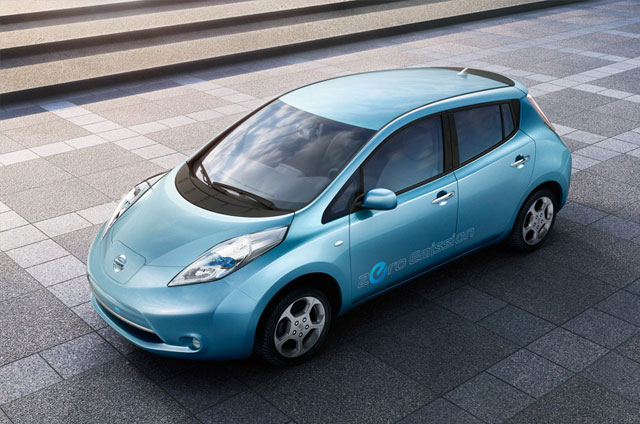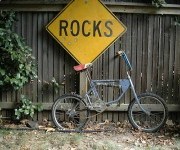Elly Blue just finished a monthlong Dinner & Bikes tour around the western U.S., along with Portland bike filmmaker Joe Biel and traveling vegan chef Joshua Ploeg. This is one of her thrice-weekly dispatches from the road about bicycle culture and economy. Read them all here.
The great 2011 Dinner & Bikes tour is officially over. We got home this weekend and did our final event here in Portland. To wrap up, I’ve put together a Q&A — mostly questions that have been asked by others over the course of our tour, but since they’re not here to ask, I’m going all James Lipton, and interviewing myself.
First, to get a real taste of the tour — the people, the meals, the bikes — check out this movie Joe made:
Q. Are you really biking around the country with all that stuff?
A. No, we drove: three of us, a pop-up bookstore, and our luggage in a tiny rental car. I relearned a lot of things about cars, like how you have such limited visibility and how going 50 miles per hour can feel unbearably slow. And oh, the stress! But the bookstore justified it for me in the end. It was a delight to see people respond to it.
Q. What surprised you?
A. We did a tour last year called Bikestravaganza, and there was a palpable increase of interest in bicycling in just the last year. It’s happening, folks, right now. From Provo to Santa Monica, Topeka to Nevada City. Even Minneapolis isn’t content to stop — and it is the most bike-friendly city in the U.S.
But then, some cities I that expected to be bike utopias have stalled out somewhere down the line. Santa Barbara in particular has a huge population of people who ride, but they just elected a city council that seems disinclined to fund any bicycle projects, and there’s even an anti-bike movement that seems to have some influence.
Q. Did you notice any bike economics trends on the ground?
A. One topic seemed to be on everyone’s mind: Parking. Bike corrals (on-street parking spaces that have been converted to bike racks) are on the verge of becoming mainstream. Bike parking is low-risk for politicians and planners. It doesn’t require huge changes in street design. Business owners are agitating for more because it translates directly into paying customers. I think bike parking is also appealing because it’s low cost and you can tap into creative funding streams, like arts money for sculptural racks.
Q. Best biking city?
A. The surprise standout for me was Tucson. I predict it’ll be the League of American Bicyclists’ pick for No. 1 bicycling city in the next three years. They’re doing it all, and they’re getting it right. Major streets have been triaged with bike lanes and the city is building a network of state-of-the-art bike boulevards. Meanwhile, the county is spending millions on a 55-mile network of connected bike trails that are, like the ones in Minneapolis, designed for transportation, with two lanes and a separated walking path — they’re even building a new bridge in one place so there isn’t a squeeze. And Tucson is blessed with an energetic bike culture that is extremely equity minded, from BICAS, the arts-focused bike project, to El Grupo, a road-riding group for Latino/a youth.
Q. Worst biking city?
A. Las Vegas, hands down. But people ride there anyway. Every day. That was one of the best parts of the trip — watching people faced with adverse riding conditions get on their bikes anyway. When they start riding in big groups, that’s how change happens.
Q. Best bike lane?
A. The best bike lanes weren’t lanes at all — they were the wide streets that make up the residential grid of Provo, Utah. On a Saturday afternoon, there were barely any cars.
Q. Worst bike lane?
A. The worst bike lanes also aren’t lanes — they’re “sharrows” (an amalgam of arrow and “share the road”). In theory, I like sharrows — they’re like a giant, cheap billboard for bicycling. They’re also a politically palatable alternative to making room on the road for a real bike lane. But it makes me wince when cities put them directly in the door zone, like they do in Sacramento, or — in most cities — on fast, high-traffic streets where drivers and bikers alike ignore them.
Q. What do you want to bring home to Portland?
A. The bike freeways in Minneapolis and Tucson, please. (I’m not going to call them trails or paths when they’re built properly like this.) And it would be great to see more of the can-do attitude that we found in Kansas.
Q. What next?
A. We’ll be going on a similar tour in April, starting in Kansas and heading east. Maybe we’ll stop in your town? Also, I’m working on a book about bicycling and the economy, based on the posts I’ve shared with you here as well as what I’ve learned from the places we stop on tour. But first things, first — I’ll continue writing about bikes here on Grist three times a week for your pleasure and inspiration. What do you want to read about?



